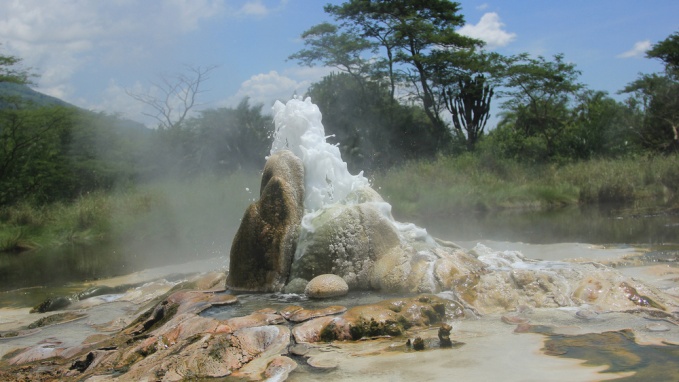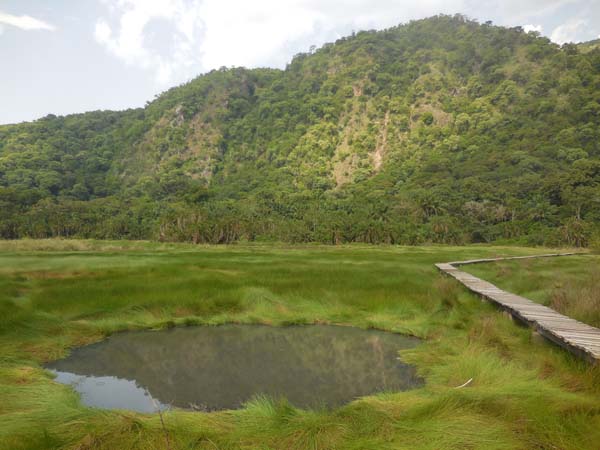Semuliki National Park
Semuliki National Park is located in Bundibugyo district in western Uganda. It is known as the true birders’ haven due to wide range availability of the bird species that can be sighted with in this park. It started as Semuliki Forest Reserve in 1932 and later was upgraded into Semuliki National Park in 1993. This park covers 220 km² with an altitude of 670-760m above sea level. Semuliki National Park is one of the newest national parks in Uganda, made known by the Sempaya Hot Springs. The water in the sempaya hot spring boils to the boiling point over 100°C and the visitors can test it by putting in raw eggs which will be hard-boiled after ten minutes.

In addition to the Sempaya hot springs, the park has several attractions ranging from primates like chimpanzees, mammals such as elephants, De Brazza’s monkey, Red-tailed monkey’s, pygmy antelope, flora and fauna and a wide range of bird species as explained below;
- The park has over 60 mammal species, including forest buffalos, leopards, hippos, blue monkeys, water chevrotains, Olive Baboons, bush babies, civets, elephants, and the pygmy flying squirrels, red-legged squirrels, and bay duiker. The park also has some primate species including Chimpanzee and almost 460 butterfly species.
- The vegetation of the park is predominantly medium altitude moist evergreen to a semi-deciduous forest with the most beautiful flora and fauna. The most common tree species in Semuliki national park is the tree Cynometra alexandri.
- Semuliki National park is home to more than 400 bird species. About 216 of these bird species are true forest birds including the rare Forest Ground Thrush. Five species are endemic to the Albertine Rift ecosystem and among other species.
Semuliki National park has got several activities taking place ranging from birding, Cultural encounters, Hiking in River Semuliki, nature walks, watching boiling water in sempaya hot spring among others that will attract the attention of the visitors as explained below
Birding: This Park is known as the birder’s haven because it harbors several bird species. This activity is normally conducted in the forested areas which are best havens for the bird species, towards River Kirumia, and towards Lake Albert. In the birding activity, visitors are able to see several bird species including; the breasted kingfishers, dazzling Red-throated bee-eaters, yellow-throated tinker bird, Honey guided Greenbuls, forest hornbills, yellow-throated Nicator, white-crested hornbill, red-billed Dwarf Hornbill, the Great Blue Turaco, Piping Hornbill, Black-casqued Wattled Hornbill, Red-rumped Tinkerbird, African Piculet, Maxwell’s Black Weaver, White-throated Blue Swallow, Nkulengu Rail, Yellow-throated Cuckoo, Piping Hornbill, Red-billed Dwarf Hornbill, Black Dwarf Hornbill, White-crested Hornbill Yellow-throated Nicator, Leaf-love, Swamp Palm Bulbul, Lemon-bellied Crombec, Gabon Woodpecker, Crested Malimbe, Red-bellied Malimbe, Blue-billed malimbe, Chestnut-breasted and the Ross’s Turaco.
Boat cruise: In Semuliki national park, this activity is carried out on Lake Albert and River Semuliki and in the process, some water birds like the rare Shoebill storks, Abyssinian ground hornbills, red-throated bee-eaters, African Fish eagles and Kingfishers are seen. Also, some wildlife such as Hippos are seen in Lake Albert.
Nocturnal Game Drives: This activity is done at night with the help of guide rangers and sport lights. Night game drive is a rare activity which enables the visitors to see the animals which were not seen during the day including carnivores
Hiking and nature walk: This activity involves the three trails which include; the Kirumia trail, the sempaya Nature trail, and the Red monkey Trail.
- The 13km Kirumia Trail: this trail runs through the heart of the forest to the Semuliki River. In this trail tourists are able to closely see the beautiful Flora and Fauna in the forest. This 8-hour round trip starts early in the morning at around 8 am and is perfect for birders
- There is also the 8km Sempaya Nature Trail. In this trial, the visitors can view the hot springs and primates. This is a 2-4 hour hike that can take place in the morning or afternoon according to the visitor’s wish. This is the shortest trail
- The 11km Red Monkey track: In this trial, the visitors follow the eastern border of the park to the river Semuliki and in the process, they see the rare deBrazza’s monkey.
Exploring the Sempaya Hot springs: These hot springs are the most attractions within this park and can be explored when you visit Toro-Semuliki Wildlife Reserve. The Sempaya Hot Spring can best be reached using the shortest walking trail. These hot springs are situated in the midst of rainforest and palm trees. These Hot springs are always reached during hiking and nature walks. These interesting hot springs attract several visitors. Visitors who come to Semuliki national park are able to visit these two sempaya hot springs i.e. the Female hot spring called Nyansimbi and the male hot spring called Bintente. The male hot spring boils water to over 100 degrees centigrade. The temperature of this water are very high. Try putting a raw egg and in ten minutes it will be hard-boiled ready to eat.
Note: don’t test this water with any of your body parts because it will burn you severely.

Cultural encounters: There are four distinct ethnic groups who live near the park and all these groups can be visited by the visitors during the cultural encounters. These groups include; the Batuku cattle keepers who reside in the open plains, the Batwa pygmies who are hunter-gatherers and they live on the edge of the forest, the Bakonjo who reside on the mountain slopes and they are best known for cultivation of the slopes and Bwamba farmers who reside on the base of the Rwenzori and their major activity is farming.
Batwa experience: This activity is also done during cultural encounters. In this experience, visitors get to know the lifestyle of the Batwa’s hunter-gatherer. This group of people always depends on the Semuliki forest for food, shelter, medicine, and tools but currently, they are copying other communities on how to their standards of living like constructing houses for shelter and obtaining the medical facilities from the hospitals. The visitors have to pay some small money for this experience and buy some handcrafts to support the Batwa and to improve their standards of living. You will also enjoy cultural performances with music and dance. This takes place at Ntandi.
Currently, a historical-cultural village is being constructed where Batwa will always demonstrate about their lifestyle in the forest
Come to Semuliki national park and experience the best birding destination in sempaya and Ntandi, Watch the hot spring as you can boil a plantain and an egg, and wind up your tour with the entertainment from the Batwa and the pygmy villages as they demonstrate their culture.


